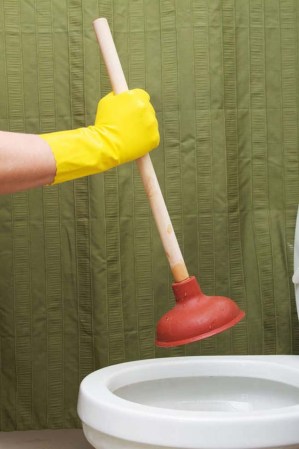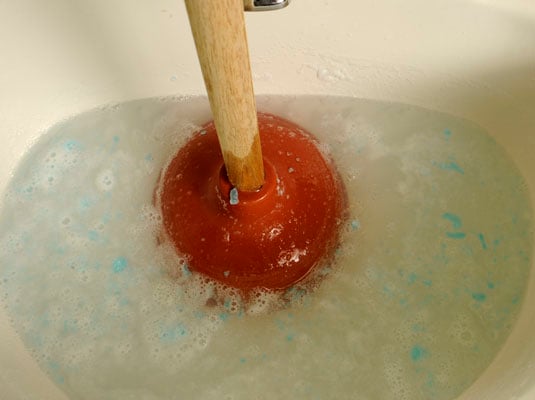Applying Plunger and Drain Cleaners: Pro Advice
Applying Plunger and Drain Cleaners: Pro Advice
Blog Article
Were you hunting for info on How to Use a Plunger to Unclog a Toilet or Drain?

Intro
Correct upkeep of home drains is essential for protecting against obstructions and making sure smooth water flow. Among the secret tools in every home owner's toolkit is the plunger, alongside numerous drain cleansers created to tackle stubborn clogs properly. This article explores just how to utilize bettors and drain cleansers properly to keep your drains moving freely.
Section 1: Recognizing Plungers
Kinds of Plungers
There are a number of sorts of bettors readily available, each developed for various sorts of drains pipes and obstructs. The most common kinds include cup bettors, flange plungers, and accordion bettors.
Exactly How Plungers Work
Bettors deal with the concept of producing pressure and suction to remove clogs. When effectively applied over a drainpipe, they produce a vacuum cleaner that can pull out particles or separate obstructions.
Picking the Right Plunger
Choosing the appropriate plunger depends upon the sort of drain and the nature of the blockage. Mug bettors are suitable for sinks and tubs, while flange bettors are better matched for toilets as a result of their layout.
Typical Mistakes with Bettors
Preventing these mistakes ensures reliable plunging: incorrect seal around the drain, not enough force, and unclear surrounding particles.
Section 2: Using Plungers Effectively
Prep work
Prior to diving, make certain the plunger covers the drain completely and develops a limited seal. Clear any type of visible particles around the drain opening.
Strategy
Start with mild plunging activities to develop suction. Boost stress gradually, making use of a stable rhythm. Repeat as essential till the drain removes.
Fixing Tips
If plunging doesn't work, attempt adjusting the seal, using petroleum jelly for a better seal, or using a various kind of plunger.
Section 3: Recognizing Drainpipe Cleansers
Types of Drainpipe Cleansers
Drain cleansers can be chemical or enzymatic. Chemical cleansers utilize strong chemicals to liquify blockages, while chemical cleaners make use of natural enzymes to break down organic matter.
Just How Drain Cleaning Company Job
Chemical cleansers respond with blockages to dissolve them, while chemical cleansers break down organic materials like hair and oil without damaging pipes.
Safety Factors to consider
Constantly use gloves and eye defense when utilizing chemical drain cleansers. Guarantee adequate air flow and follow maker instructions carefully.
Eco-Friendly Alternatives
Take into consideration making use of vinegar and baking soft drink or enzyme-based cleaners for green choices that are much safer for pipelines and the atmosphere.
Area 4: Utilizing Drain Cleaning Company Successfully
Application Strategies
Pour chemical cleansers straight right into the drain opening. Enable them to benefit the advised time before flushing with hot water. Chemical cleansers need to rest overnight.
Precautions
Prevent mixing various kinds of cleansers, as this can generate poisonous fumes. Never ever make use of chemical cleansers in conjunction with a plunger, as splashing can occur.
Handling Persistent Blockages
For consistent blockages, think about using a plumbing serpent or calling a specialist plumbing professional to avoid damage to pipes.
Verdict
In conclusion, understanding how to make use of plungers and drain cleansers successfully is vital for maintaining healthy and balanced plumbing systems. By choosing the right devices and techniques, home owners can deal with small blockages and prevent major pipes problems down the line.
How to Use a Plunger to Unclog a Drain
The humble plunger is a simple yet effective tool for breaking clogs in sinks, tubs and toilets. This handy tool is easy to use. You can make the most of its power if you understand how it works. Ready to dive in? Here’s what you need to know.
Safety First!
Never use a plunger with drain chemicals. Water will splash as you work, and the chemicals can spatter, burning skin and eyes. It’s a good idea to use rubber gloves and wear safety goggles when you work on a clog.
Choose the Right Tool for the Job
Plungers come in two different styles. Sinks, bathtubs and showers require a cup plunger. Like its name suggests, the rubber end is shaped like a cup. Use a flange plunger on toilets. These plungers have a rubber funnel extending from the cup. A plunger needs to be big enough to cover the drain.
Ready, Set, Plunge!
Coat the rim: Coat the plunger rim with petroleum jelly. This helps make a better seal.
Block outlets: Hold a wet rag over nearby outlets such as the overflow vent or the drain in a second sink.
Release air: Insert the plunger at an angle into the water. Water will displace air in the cup. A water-filled cup is more forceful than one filled with air.
Keep the plunger upright: Hold the plunger perpendicular to the drain. Use fast, forceful strokes, but make the first stroke gentle. The first stroke can create a splash if the cup still contains air. Thrust the plunger 15 to 20 times.
Snap off the plunger: The final stroke should be a strong upward motion that ends when the plunger snaps off the drain.
Repeat the process: you may need to repeat this sequence several times. When the water drains away, your work is done. High-five! https://plumbernw.com/blog/how-to-use-a-plunger-to-unclog-a-drain/

Application Strategies
Pour chemical cleansers straight right into the drain opening. Enable them to benefit the advised time before flushing with hot water. Chemical cleansers need to rest overnight.
Precautions
Prevent mixing various kinds of cleansers, as this can generate poisonous fumes. Never ever make use of chemical cleansers in conjunction with a plunger, as splashing can occur.
Handling Persistent Blockages
For consistent blockages, think about using a plumbing serpent or calling a specialist plumbing professional to avoid damage to pipes.
Verdict
In conclusion, understanding how to make use of plungers and drain cleansers successfully is vital for maintaining healthy and balanced plumbing systems. By choosing the right devices and techniques, home owners can deal with small blockages and prevent major pipes problems down the line.
How to Use a Plunger to Unclog a Drain
The humble plunger is a simple yet effective tool for breaking clogs in sinks, tubs and toilets. This handy tool is easy to use. You can make the most of its power if you understand how it works. Ready to dive in? Here’s what you need to know.
Safety First!
Never use a plunger with drain chemicals. Water will splash as you work, and the chemicals can spatter, burning skin and eyes. It’s a good idea to use rubber gloves and wear safety goggles when you work on a clog.
Choose the Right Tool for the Job
Plungers come in two different styles. Sinks, bathtubs and showers require a cup plunger. Like its name suggests, the rubber end is shaped like a cup. Use a flange plunger on toilets. These plungers have a rubber funnel extending from the cup. A plunger needs to be big enough to cover the drain.
Ready, Set, Plunge!
Coat the rim: Coat the plunger rim with petroleum jelly. This helps make a better seal. Block outlets: Hold a wet rag over nearby outlets such as the overflow vent or the drain in a second sink. Release air: Insert the plunger at an angle into the water. Water will displace air in the cup. A water-filled cup is more forceful than one filled with air. Keep the plunger upright: Hold the plunger perpendicular to the drain. Use fast, forceful strokes, but make the first stroke gentle. The first stroke can create a splash if the cup still contains air. Thrust the plunger 15 to 20 times. Snap off the plunger: The final stroke should be a strong upward motion that ends when the plunger snaps off the drain. Repeat the process: you may need to repeat this sequence several times. When the water drains away, your work is done. High-five! https://plumbernw.com/blog/how-to-use-a-plunger-to-unclog-a-drain/

As a keen reader on How To Use Your Toilet Plunger Correctly in 5 Easy Steps, I assumed sharing that excerpt was really helpful. Sharing is good. You won't know, you may very well be doing someone a favor. Bless you for your time. Revisit us soon.
Schedule Appointment Now Report this page